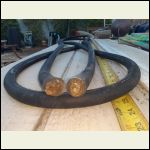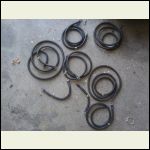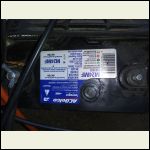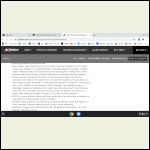| << . 1 . 2 . 3 . 4 . 5 . 6 . 7 . 8 . 9 . 10 ... 12 . 13 . >> |
| Author |
Message |
Nobadays
Member
|
# Posted: 21 Sep 2020 07:08pm
Reply
Quoting: paulz The pv-scc wiring I got with the panels looks like the same black MC4 connector wire that comes out of the panels. Silver (aluminum?) conductor, about 3/16", probably 6awg or so.
Kind of a guess... but I have had "silver" pv cabling and it was actually tinned copper. Quoting: paulz why not use copper plumbers tape I have to connect battery to battery?
If you are talking about the copper plumbers tape with all the holes in it, I think because of the holes or rather only a thin conductor to each side of the holes, it wouldn't handle the amps well. But, if you have some copper pipe laying around, folks do flatten that and use it to tie batteries together.
Quoting: paulz Does it make any difference if panels are horizontal instead of vertical?
No
Quoting: paulz Would it be OK to have the batteries (lead acid) inside as well? It's a large, well ventilated shop.
Yes and no.... they really should because a box/cabinet or something like that for a couple of reasons... accidentally dropping a wrench that shorts across the posts, bad with 1 12v battery now multiply that when you have several tied together... boom!! LA batteries really should be enclosed and then vented away from potential sparks. During Absorption and especially during equalizing they will off gas hydrogen... very flammable!
Man I live your big trees but it will make using solar a challenge. You may want to set up multiple arrays facing east, west and south wherever you get sun breaks during th he day.
|
|
paulz
Member
|
# Posted: 21 Sep 2020 09:41pm
Reply
Thanks Nobs. Well I guess it's no big deal to bore another hole in the wall and put the batteries outside in a vented box.
Well with 29 of these panels and plenty of roof I could arrange them as you say, pointed E,S,and W, and hope for some good output. The problem, as we have discussed, it having to plan for total output when in fact it's likely to be 1/10 of that.
I will start with the 6 panels, the SCC has a readout I can monitor and add panels as I go, I guess..
|
|
paulz
Member
|
# Posted: 26 Sep 2020 09:16pm
Reply
Tomorrow is the big day i'm putting my new SCC and 6 panels online. Everything is in place and cables run.
The guy I bought it from threw in all this stuff (I took 10 photos, all blurry for some reason, argh). There is a Victron battery protector, a 50 amp circuit breaker, a fuse panel, some other fuse blocks with on/off switches, and what looks like a meter that you put the wires through? Wondering what of this stuff I should use. The fuses must be for DC circuits direct off the battery bank? Where would the breaker go? What about that thing with the hole in it? And should I use that battery protector?
|
|
darz5150
Member
|
# Posted: 26 Sep 2020 09:31pm
Reply
Quoting: paulz What about that thing with the hole in it?
Possible ammeter?
|
|
ICC
Member
|
# Posted: 26 Sep 2020 10:09pm
Reply
That is a Hall effect current sensor. In your application it is used to provide a contactless, non-intrusive methiod for rfeading current flow. The attached box will be an ammeter.
Some of those can only measure in one direction, charging or discharging a battery, some are bi-directional.
The idea is that the negative wire is passed through the circle and that senses the current flow using magnetics. TRy to maintain as close to a 90 degree angle of the wire to the sensor ring. Some of those sensors open and close so the cable does not even have to be removed from a terminal for installation.
Hall effect current sensors take the place of shunt resistors which work very well, but require the negative cable to be severed and the shunt inserted in the cut wire. That is very handy for a simpler installation. The downside is the reading may wander more with temperature changes and any nearby magnetic fields may cause inaccuracy.
|
|
ICC
Member
|
# Posted: 26 Sep 2020 10:19pm
Reply
As for where the fuses and breaker should go....
Breakers are often used in the input line to an inverter because most of them can be used as a switch or disconnect. 50 amp is small for that though.
Breakers are also used frequently in the wires from the PV panels to the charge controller as well as in the output line fro the CC to the batteries. I always have both and locate them right close to the CC so it is simple to disconnect and reconnect if needed for any maintenance reasons.
Fuses can be used for all of the above but I dislike them. Also if there is high volrage and current flowing through a fuse it can be dangerous to pull a fuse out. An electric arc may cause burns or a fire. DC current is what makes electric arc weldrs work. There is a youtube video I saw yers ago that shows the arc flames continuing for many seconds when a fuse was pulled. Breakers are designed to avoid that. FYI, that is one reason DC breakers may have one end marked as up or have the terminal ends marked line and load, or all of the above.
A fuse or breaker should always be used at the PV panel combiner when there are more than 2 panels/strings connected there in parallel. One fuse or breaker per + line in the combiner box.
|
|
paulz
Member
|
# Posted: 26 Sep 2020 10:28pm
Reply
Thanks guys. I found the box, it's a DROC DC ammeter. Where would I put it, in negative load wire out of the SCC?
What about that 50a circuit breaker?
|
|
ICC
Member
|
# Posted: 26 Sep 2020 10:55pm
Reply
Quoting: paulz Where would I put it, in negative load wire out of the SCC?
Depends what current you want to measure.
Charge controller to battery? Battery to inverter? Battery to other DC only loads?
Where or how it is used may also depend on whether or not it is bidirectional.
If it is bidirectional it could be placed so all the current flow into and out of the battery passes through it. Some of those meters can measure both and display how many AH flowed into the batteries, how much flowed out and some will be able to keep track of a calculated % of battery capacity. Depends on the meters capabilities.
|
|
|
paulz
Member
|
# Posted: 27 Sep 2020 10:07am
Reply
Thanks ICC. Hey what is the purpose of the LOAD terminals on the SCC? The manual shows lights, with the inverter connected direct to the battery. Why isn't everything connected to LOAD?
|
|
ICC
Member
|
# Posted: 27 Sep 2020 10:36am
Reply
The LOAD section is limited to the amperage it can carry.
Here, copied from solar-electric.com
"Some controllers also have a "LOAD", or LVD output, which can be used for smaller loads, such as small appliances and lights. The advantage is that the load terminals have a low voltage disconnect, so it will turn off whatever is connected to the load terminals and keep from running the battery down too far. The LOAD output is often used for small non-critical loads, such as lights. A few, such as the Schneider Electric C12, can also be used as a lighting controller, to turn lights on at dark, but the Morningstar SLC lighting controller is usually a better choice for that."
However, when the LOAD portion is used you lose amp capacity for the charge side. For example if a CC is rated for 40 amps but also has a 10 amp LOAD portion, usually if you activate the LOAD section that reduces the charge side to 30 amps.
|
|
paulz
Member
|
# Posted: 27 Sep 2020 11:07am
Reply
Thanks ICC. I went through the manual again, they only make slight reference to the load feature, and it does appear to be time programmable. No mention of current rating.
|
|
paulz
Member
|
# Posted: 27 Sep 2020 01:54pm
Reply
Hey, managed to get it all hooked up without frying anything! All 6 panels still in shade showing half amp charge. Yesterday Costco had 4' LED shop lights on sale for $20, bought a couple. Plugged one in, wow, I can see in the shop! 40 watts though.
Still a lot of tidy up work. What's the suggestion for lead battery enclosure outside? Wood box, plastic totes? Need air of course, and wet weather protection.
|
|
paulz
Member
|
# Posted: 27 Sep 2020 06:03pm
Reply
Well can't say I wasn't warned.. My SCC to battery cables are only 3', but I found a choice spot for the inverter and ran 25' of 6 awg wire to it, 12v. My chop saw is bogging down, I think it's the wire?
|
|
paulz
Member
|
# Posted: 28 Sep 2020 11:32am
Reply
These big panels had unshielded copper ground wires attached to the frames in their grid tied prior life. Do I need that?
|
|
Steve_S
Member
|
# Posted: 28 Sep 2020 12:13pm
Reply
Solar Panels frames should be grounded. They are NOT grounded to an electrical ground, this is for simple lightning earth grounding. Here the required ground line should actually be a Green Jacketed Copper wire so it is readily identifiable as a ground.
The most common approach is to install a ground stake at the panel rack and ground the panels frames / metal racking to that ground post. Never ground you AC House Wiring or anything else to ths Panel Ground. Thta must be different and follow appropriate codes for that.
Lightning protection is rarely mentioned by anyone until AFTER they've been cooked. Lightning can and does wreak havoc, proper protection for DC & AC circuits should be considered and installed as appropriate for the specific installation and configuration. There are many lightning arrestors, most are good BUT beware of the discounted crap out there, there is quite a bit floating about on ebay/amazon etc.
I am a Midnite Solar User with most of my equipment from them, including their Lightning Protection Modules which are very highly rated. Stick to ONLY Name Brand Quality ones.
Here is a link to Midnites Products for this. NOTE, there are different ones, AC or DC and more.
http://www.midnitesolar.com/products.php?menuItem=products&productCat_ID=23&productCa tName=Surge%20Protection%20Devices#
|
|
ICC
Member
|
# Posted: 28 Sep 2020 02:53pm
Reply
Believe Steve. Midnite makes the best surge ptotectors to use for lightning protection. I have several in use. It is sort of riddiculous to have thousands of dollars or equipment and trust to luch. Of course some locations (mine) sees much more lightning activity than many other locations. I have had to replace Midnite SPD's because they get used up a little every time they send a bolt to earth. They have an indicator LED.
They are only as good as the grounding rod. If soil is dry, sandy or rocky multiple grounds are advised. I use both 5/8" x 8 foot copper clad rods and 16 x 16' buried copper plates.
My PV arrays are lightning grounded and all the buildings that have power connections have grounding rods and plates for the lightning protection system. Buildings all have air terminals (lightning rods) on the roof or highest points. I installed the earthing rods and plates in low points and have intentionally directed run off to those locations to help keep the earth as moist as possible for less electrical resistance. (I refer to these as earthing rods to differentiate them from the electrical system grounding rods. NOT the same thing and they are not interconnected, except for the fact both are in the earth.
|
|
paulz
Member
|
# Posted: 28 Sep 2020 05:25pm
Reply
Thanks guys, good info.
|
|
paulz
Member
|
# Posted: 3 Oct 2020 08:18pm
Reply
Went on a Craigslist run today. Scored this 20' 2/0 garden hose size cable for $20. Going to cut it in half, will reach from my battery bank through the back wall and to my inverter on a table. And he threw in these battery interconnect cables!
Now all I need is some sun!
00t0t_dLVogk810Sx_0C.jpg
| 
20201003_154806_resi.jpg
|  |  |
|
|
FishHog
Member
|
# Posted: 4 Oct 2020 09:22am
Reply
You sure do well on Craig’s list paulz. Good buy there
|
|
paulz
Member
|
# Posted: 8 Oct 2020 10:22am
Reply
Thanks FH. Yeah that was a timely score. I replaced the 6awg wire to the inverter yesterday, now the table saw runs as well as on a generator.
I've been running the Epever SCC in default mode for a week or so. Yesterday I finally started looking at options, and changed the battery type from gel to flooded. Guess I need to change the AH from 200 to the sum of my 4 group 24s in parallel. Whatever that does. Not sure if any of these other parameters need messing with.
|
|
razmichael
Member
|
# Posted: 8 Oct 2020 12:19pm
Reply
Recently added an Epever CC into my system (with added panels and a new battery bank). The total capacity is really only used to provide estimates on status. The other parameters may actually be more important. My Trojan batteries specs for charging are a fair bit different than the default parameters, especially Equalization voltage. I matched the CC controller to the battery specs recommended by Trojan. Obviously it will depend on your batteries.
|
|
paulz
Member
|
# Posted: 8 Oct 2020 05:33pm
Reply
Cool, another Epever user! What type of battery is a Trojan? I'm using standard deep cycle group 24 RV/Marine type flooded batteries, probably not a lot of variance in charging parameters for them I'm guessing.
BTW, while I was rewiring yesterday I changed from having 3 batteries daisy chained (parallel) off the 4th that was hooked to the CC and inverter to cabling each of the 3 batteries to the 4th directly. Probably doesn't make much difference but it seemed the better way and the cables were long enough.
|
|
Steve_S
Member
|
# Posted: 8 Oct 2020 05:50pm - Edited by: Steve_S
Reply
How you wire & route your battery bank can and does make a big difference, especially for keep batteries equal & balanced.
The Gold Standard Reference that Victron put's out explains everything very well and covers different chemistries as well.
https://www.victronenergy.com/upload/documents/Wiring-Unlimited-EN.pdf
Also a good overview / guide to Lead Acid Batteries is here: https://www.solacity.com/lead-acid-battery-care/
BE CERTAIN your Battery Profiles are proper for your Solar Controller & Inverter otherwise you can cause serious damage. ALWAYS refere to the Manufacturer's Specification & Data sheets for proper paramters, values and maintenance instructions. FLA needs regular babysitting and care.
|
|
razmichael
Member
|
# Posted: 9 Oct 2020 09:28am
Reply
Quoting: paulz Cool, another Epever user! What type of battery is a Trojan? I'm using standard deep cycle group 24 RV/Marine type flooded batteries, probably not a lot of variance in charging parameters for them I'm guessing
Mine are 6V Trojan L16H-AC (x 2) batteries Flooded Lead- 435Ahrs. The manufacturer specs are likely more "aggressive" than a your RV/Marine batteries but still a good idea to check the recommendations and see if it is worth adjusting the CC to match.
Steve_S has provided some good references to review regarding wiring. As soon as you get over two batteries there are some impacts on how they are wired (individual cable lengths, parallel and serial connections etc). This impact increases the more batteries you have - this is why many with larger banks use bus bars to make it easier to wire properly.
|
|
paulz
Member
|
# Posted: 9 Oct 2020 02:06pm
Reply
Yes, great reading there Steve S, except now I have to worry about ripple and such. And rewire my battery bank, again.
Also need to have a look at my batteries and see if Delco posts and charge parameters on them. Being RV Marine batteries I'm guessing they are just meant to be hooked up to a car type alternator or charged off a common battery charger.
|
|
razmichael
Member
|
# Posted: 9 Oct 2020 05:33pm
Reply
They would be “hybrid†so likely nothing too special but will last much longer with a good smart charger. Likely the charging parameters will be pretty close to the default but doesn’t hurt to see if some adjustments might be in order. As you have a programmable CC might as well take advantage.
|
|
paulz
Member
|
# Posted: 11 Oct 2020 06:02pm
Reply
Took a photo of the top of my batteries. AC Delco M24MF. Here's what they say about charging, not much.
Also reconfigured cabling according to the Victron link. One battery provides the positive, other battery at end of string the negative.
battery.jpg
| 
Screenshot_2020101.png
|  |  |
|
|
paulz
Member
|
# Posted: 15 Oct 2020 06:38pm
Reply
Hey just curious about using a generator to charge batteries that are in the solar config. Can a conventional car battery charger (12v, 2-10amp) be hooked to the battery bank without disconnecting the SCC?
Sometimes I run a generator while using power tools, might as well charge batteries.
|
|
paulz
Member
|
# Posted: 16 Oct 2020 11:08am - Edited by: paulz
Reply
Well after some searching it sounds like I can hook up a battery charger off a generator and not disconnect the SCC or inverter (it's not an inverter/charger) so I will try that soon.
On another note, I ordered some MC4 stuff from an outfit called Renogy_Solar off Ebay (don't know if they are the real Renogy or someone using the name). Also ordered some other MC4 parts from another Ebay vendor on the same day. That stuff arrived about as expected, 5-7 days. On that day, the Renogy vendor finally posted a 'shipping label created' note. Still haven't received it after 10 days, and they are located in my state. Adding more panels will have to wait for my next cabin trip next week, assuming they show up.
Their feedback has similar negativity but somehow they maintain a 97% approval rating. Guess I'm one of the unlucky ones but be warned.
Tried to buy local, non of the big box or hardware stores have it around here.
Maybe it's Covid related but haven't had delays otherwise on many items.
|
|
Steve_S
Member
|
# Posted: 16 Oct 2020 11:32am
Reply
Renogy does have a reputation, similar to that of using Recycled Toilet Paper. The stories are more than numerous and the stuff people have suffered with them is well posted everywhere on the web.
Now EPEver is a Good Quality Value Brand that does stand behind their products and do well by their customers, and their pricing is often better than Crap Renogy.... but they do not have all the products that the others flog.
Santansolar for anyone is the USA has increadibly great deals on New & Used Solar Panels unfortunately no such "Great Outlet" exists in Canada.
REFS:
Santan Solar USA: https://store.santansolar.com/product-category/solar-panels/
Solar Shopping Mall (Canada) for discount, new/ used or grade-b panels:
https://www.solarshoppingmall.com/Solar-Panels_c_7.html
EXAMPLE: 320W MONO SOLAR PANEL GRADE B
$173.00 CDN
|
|
| << . 1 . 2 . 3 . 4 . 5 . 6 . 7 . 8 . 9 . 10 ... 12 . 13 . >> |

